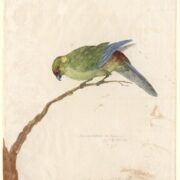Artistry on the high seas: Captain Cook’s artists

Sydney Parkinson, Family: Carcharhinidae Genus/Species: Prionace glauca, 1769. Image and original data provided by Natural History Museum, London.
On his famous three voyages to the South Seas, British explorer Captain James Cook charted the largely unexplored Pacific Ocean, achieved the first recorded European contact with the eastern coastline of Australia and the Hawaiian Islands, and completed the first recorded circumnavigation of New Zealand. But Cook’s nautical feats are only part of the story; of equal importance are the contributions made by the artists who went along on his journeys, risking their lives–and sometimes losing them–to illustrate the animals and plants they encountered for science and posterity. Here are their stories.
First voyage: Sydney Parkinson
Despite the less than ideal working conditions—at one point in Tahiti swarms of flies ate the paint as he worked!—Sydney Parkinson managed to draw thousands of plants and animals collected on Cook’s first voyage to the Pacific. Sadly, Parkinson died at sea in 1771 of dysentery contracted during the journey. The Artstor Digital Library includes nearly 1,000 images of his botanical and zoological illustrations, both those executed by him during the expedition and others completed later by other artists from his initial sketches.
Second voyage: Johann Georg Adam Forster
- Johann Georg Adam Forster, Red-rumped parrot, Cyanoramphus (genus); zealandicus (species), 1774. Image and original data provided by Natural History Museum, London.
In 1772, Cook set sail with a new team of scientists and artists, including Johann Georg Adam Forster, an illustrator. Happily, things turned out much better for Forster than they did for his predecessor. His report of the journey, A Voyage Round the World, was a great success and is still considered an exemplar of modern scientific travel literature. He is represented in Artstor by almost 600 drawings and watercolors of plant and animal specimens collected throughout the South Seas by his father, the scholar Johann Reinhold Forster.
Third voyage: William Wade Ellis
For his last voyage, Cook took along two new artists, John Webber and William Wade Ellis. Webber was the official artist, while Ellis was supposed to be travelling as a surgeon’s assistant. Not much is known about Ellis, and in his lifetime his reputation was eclipsed by that of the better-known Webber, but the excellence of his bird paintings and his written descriptions indicate that he was knowledgeable in science. Unfortunately, upon returning to the Hawaiian Islands for repairs, Cook was killed before the expedition was completed. Cook’s ill-fated third voyage is represented in Artstor by approximately 100 drawings by Ellis depicting animals and plants collected throughout the journey.
Learn more about Cook’s voyages to the South Seas collection from the Natural History Museum, London on the Artstor website, and view the natural history illustrations in the Artstor Digital Library.
You may also be interested in: Audubon and Audubon
